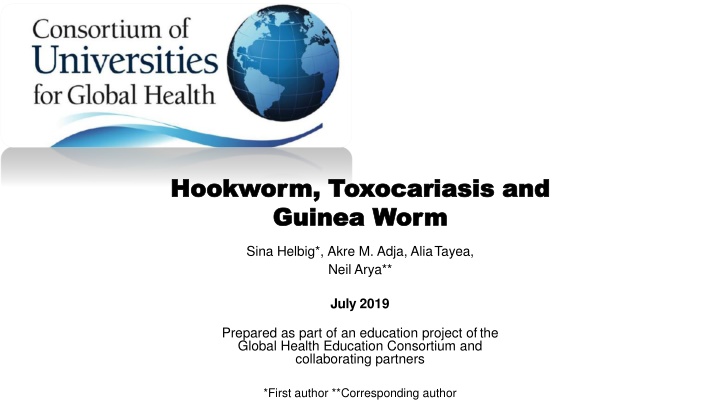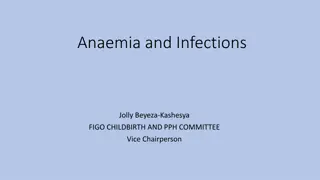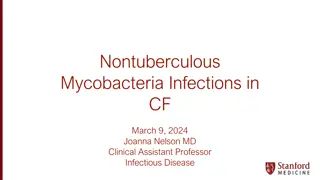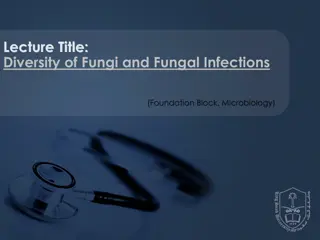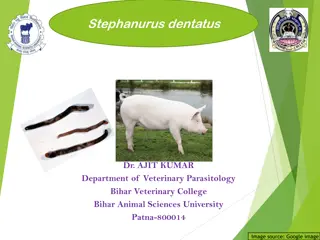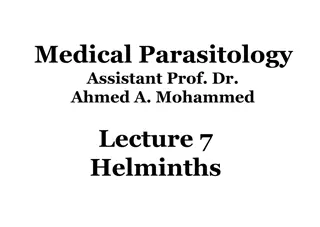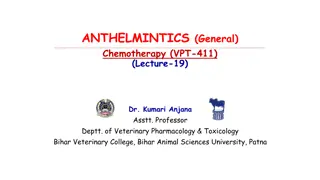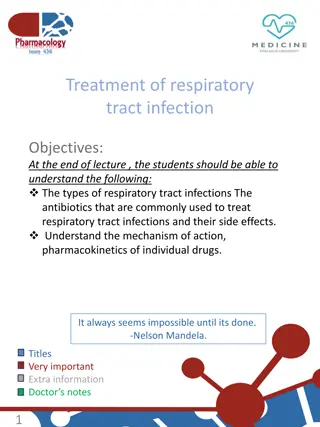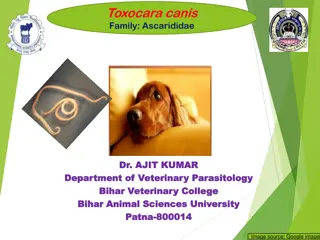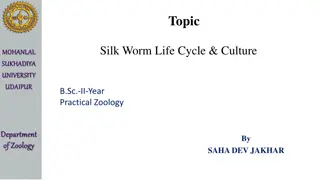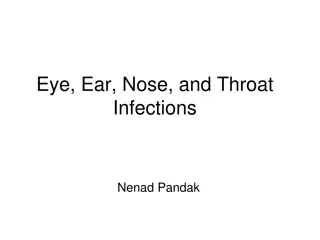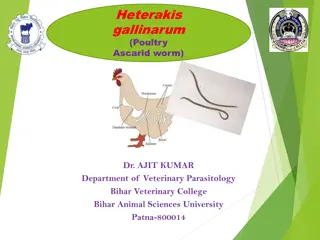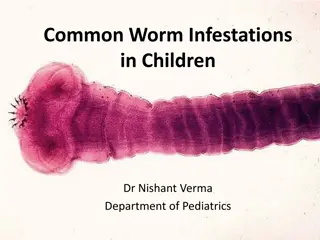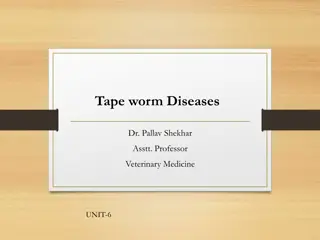Overview of Hookworm, Toxocariasis, and Guinea Worm Infections
These infections are significant global health issues affecting millions of individuals worldwide. Hookworm infection, a leading cause of iron-deficiency anemia, is prevalent in tropical and sub-tropical regions. Risk factors include poor sanitation and walking barefoot on contaminated soil. The biology of hookworms involves male and female worms that produce thousands of eggs daily. Toxocariasis and Guinea Worm infections also pose health risks and require proper education and preventive measures.
Download Presentation

Please find below an Image/Link to download the presentation.
The content on the website is provided AS IS for your information and personal use only. It may not be sold, licensed, or shared on other websites without obtaining consent from the author.If you encounter any issues during the download, it is possible that the publisher has removed the file from their server.
You are allowed to download the files provided on this website for personal or commercial use, subject to the condition that they are used lawfully. All files are the property of their respective owners.
The content on the website is provided AS IS for your information and personal use only. It may not be sold, licensed, or shared on other websites without obtaining consent from the author.
E N D
Presentation Transcript
Hookworm, Toxocariasis and Hookworm, Toxocariasis and Guinea Worm Guinea Worm Sina Helbig*, Akre M. Adja, AliaTayea, Neil Arya** July 2019 Prepared as part of an education project ofthe Global Health Education Consortium and collaborating partners *First author **Corresponding author
Hookworm, Toxocariasis and Guinea Worm Ancylostoma duodenale, Necator Americanus Intestinal Nematode Aliaa Tayea*, Sina Helbig, Akre M Adja, Neil Arya** Prepared as part of an education project ofthe Global Health Education Consortium and collaborating partners *First author **Corresponding author Page1
INDEX: Hookworm, Toxocariasis and Guinea Worm Hookworm --------------------------------------------------------- (4.1 -- 4.7) Toxocariasis ------------------------------------------------------- (5.1 -- 5.8) Guinea Worm ----------------------------------------------------- (6.1 -- 6.7)
4.1 Epidemiology Common disease with at least 740 million people infected globally (estimates up to >1 billion) Causes more morbidity than any other geohelminth principally by consequences of iron-deficiency anemia o Hookworm infection is the leading cause of iron deficiency anemia worldwide Largely worldwide distribution, prevalent in all tropical and subtropical countries, especially sub-Saharan Africa, South China, Pacific and South-east Asia Page4
4.2 Risk factors Poor sanitation Walking barefoot in soil contaminated with feaces Infection by A. duodenale probably also occurs by oral and transmammary route Photo: http://www.johntyman.com/africa/a442.jpg Page5
4.3 Biology Human infection caused by 2 hookworms o Hook from the fact that the head is slightly bent relative to the rest of the body o Small white-grey or reddish-brown thread like worms Ancylostoma duodenale o Buccal capsule containing 2 pairs of teeth for attachment to the small-intestinal mucosa o Male: 1 x 0.5 cm o Female: 1.2 x 0.6 cm o Maximum egg output 15-18 months after infection o Interval between infection and disappearance of eggs from stool with death of the worm averages 1 year o Female produces 25,000-35,000 eggs/day (18-54 million during its lifetime) o Adult worm lives 1-3 yrs (often longer) https://msu.edu/course/zol/316/hookscope.htm Page6
4.3 Biology Necator americanus o Shorter and more slender than A. duodenale (1 x 0.4 cm) o Smaller buccal capsule than A. duodenale o A pair of cutting plates instead of teeth o Eggs slightly larger than A. duodenale (70 x 40 m) o Female produces ~20,000 eggs daily o Adult worm lives 3-10 yrs (3-5yrs for female worm) Humans are definitive host Page7
4.3 Life cycle Eggs are deposited in duodenal lumen Leave body through feaces If deposited in damp shaded soil they hatch into rhabditiform larva (first stage) o Feeds on organic debris o Becomes elongated and fully developed Larva moults to form a filariform larva (infective stage moves away from the feaces into soil) Protected from desiccation, they can live in warm damp soil for up to 2 yrs Filariform larva penetrates skin of host when contact initiated receives host signal to resume development Enters vasculature travels to lung breaks through alveoli, moves up trachea, is swallowed and reaches small intestine During migration 3rd moult takes place, upon arrival in intestine 4thmoult Worm attaches to the small-intestinal mucosa where it sucks blood A. duodenale can also infect by ingestion Page8
4.4 Pathology 3 stages (first two usually only seen in primary infection, during larva migration phase) o Invasive phase o Vesiculation and pustulation at entry site o Migration via venous system through the lungs with small hemorrhages into the alveoli and eosinophilic and leucocytic infiltration Coughing, asthma and bronchitis (Loeffler'sSyndrome) Larvae moved up, either by coughing or ciliary escalatorto pharynx where they are swallowed move to intestines o Established infection by adult worms in intestine Seen in the inhabitants of endemic areas May be asymptomatic or, in case of severe infections, lead to anemia Page9
4.4 Symptoms Initial invasive stage o Entry site of larva: ground itch (irritating vesicular rash) Limited to the area around entry points of the body (usuallypalms and soles, between toes) o Lasts up to 10 days Larva migration phase o Appear 1-2wks after the primary infection, and depend on worm burden o Pulmonary symptoms with dry cough, asthmatic wheezing, fever, high eosinophilia Wheezing less pronounced than with A. lumbricoides o Low-grade fever may be present o Entire episode usually of 2-3m duration mostly self-limiting Page10
4.4 Symptoms Later, established infection o Epigastric pain upon worm migration Can be relieved by food DDx: duodenal ulcer! Symptoms peak at 30-45d after infection and gradually disappear o Occult blood in stools to frank melena Results when hookworm detaches from one site in intestine to move to another location o Iron deficiency anemia Occurs after iron stores are depleted o Protein-depleting enteropathy (hypoalbuminemia): puffiness, edema o Retinal hemorrhages Page11
4.4 Symptoms Effects of anemia: malaise, digestive disturbance, no wasting o Each worm consumes .03-.6 mL of blood per day o Usually 40-160 worms are enough to cause anemia o 500-1000 = significant blood loss and anemia even in the presence of iron supplementation o Shortness of breath, high output heart failure Severe infection - persistent anemia in children may have severe long-term consequences o Stunting of growth and development, cognitive impairment Page12
4.5 Diagnosis Detection in stool o Ova: thin clear shell o Sometimes also detection of rhabditiform larva in stool (DDx: Strongyloides) o Ova appears about 42d after infection o Sensitivity can be increased by examining multiple samples over consecutive days o Kato-Katz smear provides quantitative estimate (samples should be examined within an hour of preparation or earlier, depending on heat and humidity conditions) Serological diagnostic o Multiplex real-time PCR Page13
4.6 Management/Treatment Treatment of anemia (iron supplementation) Treatment is targeted against adult stages Albendazole o 400mg single dose (80% cure rate) o 200mg daily x 3 days (100% cure rate) Mebendazole: only partially active and treatment over multiple days might be required for severe infections 100mg orally twice a day x 3 days or 500mg orally once Levamisole and pyrantel pamoate are less effective 11 mg/kg (up to a maximum of 1g) orally daily x 3 days https://www.cdc.gov/parasites/hookworm/health_professionals/index.html#tx Page14
4.7 Control Proper disposal of faeces to minimize risk of contact with body o Provision/proper use of sanitationfacilities Good hygiene to break indirect fecal-oral transmission route In some (endemic) areas regular de-worming of children and examination of lactating mothers Photo:http://artforgorillas.wildlifedirect.org/files/2010/03/Washing-Hand.- Photo-by-Molly-Feltner.-Staying-Healthy-lessons-by-Art-of-Conservation.- Rwanda-2010.jpg Page15
5.1 Epidemiology Toxocariasis Result of infection with dog ascarid Toxocara canis (most common) or the cat ascarid Toxocara cati Cosmopolitan in distribution Often associated with A. lumbricoides and Trichuris trichiura infection Mortality unusual; morbidity largely due to ocular involvement Toxocariasis is an important cause of reduced visual acuity in tropical areas o Photo:http://www.cdc.gov/parasites/images/toxocariasis/home_page_image_toxocariasis.jpg Page16
5.2 Risk factors Exposure to (particularly young) dog and cat faeces o Direct contact not necessary, as eggs need weeks of developmentin soil to become infective o Small children; more hand-to-mouth contact duringplay Outdoor parks in urban and suburban environments o Most likely to be contaminated by animal faeces o Children playing in the sand/soil higher risk of accidentally ingesting Toxocara eggs Pet ownership (litter) Geophagia (both in children and adults) Page17
5.3 Biology Definitive hosts are dogs (T. canis) and cats (T. cati) Humans are incidental hosts; parasite does not undergo normal development in humans after ingestion Infected embryonated eggs ingested after exposure from soil/sand contaminated by dog/or cat faeces Eggs ruptured in GI tract, releasing larvae; further development is arrested at the larval stage Morphology similar to A. lumbricoides o Male worms: 40 60 mm long; Female worms: 65 - 100 mmlong o Eggs: 85 x 75 m Page18
5.3 Biology Larvae survive in humans for months to years, causing damage to tissues as they wander through body o Complex mechanisms to evade immune system 3 recognized syndromes o Covert toxocariasis (long-term exposure to migrating juvenilelarvae) o Visceral larva migrans (VLM) o Ocular toxocariasis (ocular larva migrans or OLM) Photo:http://cms.revoptom.com/handbook/IMA GES/oct02_sec5_fig7.jpg Page19
5.3 Life cycle Life cycle in cats and dogs is similar to A. lumbricoides infection in humans Difference: transplacental infection is common with offspring shedding numerous eggs from birth Adult animals excrete few eggs Dogs/cats are infected by ingesting eggs from contaminated soil Eggs hatch in stomach of humans Second stage larvae penetrate mucosa to enter circulation via the mesenteric vessels intestinal viscera and liver may stay there or travel to lungs, brain, eye. Larvae are eventually destroyed by granulomatous reaction blocks further migration and causes pathology Larvae can remain alive for > 11yr in humans Page20
5.4 Pathology Visceral larva migrans (VLM) o Stage larvae are arrested mostly in the liver where they cause few or many lesions. Granulomas form which can be seen as white subcapsular nodules o Other sites: lungs, kidneys, heart, striated muscle, brain, eye Ocular toxocariasis o Granulomatous reaction forms a large subretinal mass with a superimposed pathology of choroiditis which can closely resemble retinoblastoma Tissue damage due more to host inflammatory response to larvae than to parasite itself Page21
5.5 Symptoms Symptoms depend on intensity of infection; most cases asymptomatic Incubation period dependent on worm burden (weeks to years) VLM can be self limiting to lethal (unusual) Ocular lesions can lead to strabismus, decrease in vision or blindness Milder infection more common in adults: ocular toxocariasis Page22
5.5 Symptoms Covert toxocariasis Covert toxocariasis in children (mainly <5yrs) usually subclinical or mild febrile illness o May result from long term exposure to migrating juvenile larvae o Can manifest as cough, behavioural or sleeping problems, headache, chronic/recurring abdominal pain, anorexia May also have lymphadenitis, hepatomegaly Toxocara titres lower than in VLM, and eosinophilia less common and less pronounced Long-term exposure of larvae to lungs can lead to asthma Page23
5.5 Symptoms - VLM Classic VLM syndrome o Fever, coughing/wheezing, anemia, hepatomegaly, eosinophilia, positive Toxocara titre o Most commonly with heavy infection in childhood Pulmonary signs (e.g. coughing, wheezing), asthma Cardiac dysfunction Nephrosis CNS involvement: aseptic meningitis, mass lesions causing seizures*, paresis (spinal cord lesions) *less common, but may contribute to higher rates of epilepsy in partsof developing countries with high infection rates Page24
5.5 Symptoms Ocular toxocariasis Usually unilateral Presenting symptoms is often strabismus due to macular damage low grade iridocyclitis can progress to general endophthalmitis and retinal detachment o Eyepain If lesion is central decrease in visual acuity Solid retinal tumor close to macula In early stages closely mimics retinal neoplasm since it is raised above the level of the retina Later lesion remains a clear-cut circumscribed area of retinal degeneration Page25
5.6 Diagnosis SVLM Stable persistent eosinophilia (sometimes >70%),leucocytosis, hypergammaglobulinemia Decreased albumin:globulin ratio, increase in IgG, IgH, anti-A and anti-B isohemaglutinin titres High resolution ultrasonography: hypoechoic areas inliver Demonstration of larvae is difficult and seldomachieved, sometimes found partially destroyed in centre ofgranuloma Serology: ELISA using excretory-secretory antigens harvested from second stage larvae in vitro Sensitivity > 95%, specificity > 90% Can be improved by indirect Ab competition: e.g. specificIgE, IgG4 Ocular toxocariasis o Ophthalmological examination; second stage larvaerarely seen with slit-lamp microscope in anterior chamber of eye Page26
5.7 Treatment Anti-helminthic therapy for VLM o Albendazole (preferred), Mebendazole,Thiabendazole o DEC reportedly more effective than benzimidazoles but more adverse reactions In VLM, eosinophilia may persist over months after clinical cure (decrease in hepatomegaly, subsiding fever) Possible increased inflammatory reaction during therapy; corticosteroids often beneficial Treatment of OLM more difficult, surgical therapy may be needed for severe disease Recurrence unlikely, providing risk factors mitigated Page27
5.8 Control Breaking hand-to-mouth transmission especially in children o Hand washing before eating, especially after handling pets, pet litteror soil General education on disease, transmission and risk factors for toxocariasis Animal control in public areas o Fencing, limiting access to playgrounds Regular de-worming of dogs and cats Photo:http://www.vetbiomed.murdoch.edu.au/numbatnews/conte nt_images/Deworming-CommunityProject.JPG Page28
6.1 Epidemiology Guinea Worm Dracunculus = Latin little dragon ; also called Guinea fire worm Infection caused by nematode Dracunculus medinensis Found in abundance in natural freshwater bodies Presence is an indicator of extreme poverty Mortality is low - associated with untreated secondary infection Morbidity is high - associated with months of debilitating pain, incapacitation Photo:http://plpnemweb.ucdavis.edu/nemaplex/taxadata/Dmedinensis.HTM Page29
6.1 Epidemiology > 3.5 million cases, in 20 countries, reported in the 1980s Following eradication campaigns since 1986, dramatic reduction (>99%) in reported cases o 5,000 in2008 o <1,800in 2010 (94% in South Sudan) Sustained campaigns (largely by Carter Center) of community education, safer water provision (especially using appropriate filters), political mobilization As of 2015, dracunculiasis remains endemic in four countries: Mali, Ethiopia, South Sudan, and Chad. WHO. (2009). Action Against Worms. Newsletter http://www.who.int/dracunculiasis/epidemiology/en/ Page30
6.2 Risk factors Dependence on poor quality drinking water, unsafe water sources Drinking water from still freshwater reservoirs o Ponds, shallow wells, streams,etc. Contact of affected individuals with water sources, continuing transmission cycle Civil unrest, hindering other efforts to control disease and associated risk factors (e.g. S. Sudan) Photohttp://love2others.org/wp-content/uploads/2012/05/33.jpg Page31
6.3 Biology Nematode parasite related to filarial worms Larvae released into water by adult female worms Vectors: cyclopoid copepods (water fleas) tiny free swimming crustaceans swallow larvae after release o Development within vector, larvae infective after ~ 3wks Humans acquire infection by drinking water containing the copepod vectors infected with guinea worm larvae Stomach digestive acids kill copepods, but not larvae o Larvae migrate through stomach wall into subcutaneous tissue of abdomen, thorax Page32
6.3 Biology After 2-3 months, worms develop and mate, after which males die; females continue their development and migration Adult female guinea worm o Up to 60-80cm long and 1.5-2mmthick o Inhabits the subcutaneous connective tissues ofhumans o Located anywhere in the body; in late stage usually attractedto lower extremities (most likely to come into contactw/water) Formation of blister, which bursts after ~48hrs Female worm protrudes its tip through resulting ulcer, releasing fluid filled with larvae upon contact with water Embryos taken up by vector, and cycle begins again Page33
6.3 Life cycle o Human is seeking freshwater reservoir for relief blister ruptures discharge of first stage larvae into water o It remains protruding for the next 2-6 weeks, releasing larvae each time o Larvae are infective in water for 5-6 days o For further development must within this period be swallowed by a copepod penetrates gut wall and reaches the infective 3rd stage within 2 weeks Page34
6.4 Symptoms Usually asymptomatic in prepatent period (interval between infection of an individual by a parasitic organism and the first ability to detect from that host a diagnostic stage of the organism) First symptoms occur a few days prior to the worm piercing the skin, and largely related to hypersensitivity reaction If worm is close to joint, may also cause arthritis Dermis becomes elevated and blister develops o With intense burning, itching sensation o ~24-48 hrs later blister bursts o Intense sensations provoke patient to submerse area in water,which relieves some of the burning sensation Page35
6.4 Symptoms Further inflammation or calcification of worms may cause stiff joints in lower limbs crippling of patient If secondary bacterial infection of ulcer (common), cellulitis or tetanus can develop If worm is only incompletely extricated, the worms withdraws into the host causing a severe inflammatory reaction with ulcer formation and scarring Encysting or calcification of worms, sterile subcutaneous abscess formation Rarely migration of worms to vital organs o Brain - cerebral/subdural abscess can develop o Eyes - blindness can develop Page36
6.4 Symptoms Ulcer formed after worm emerges from burst blister; these frequently become infected. (Photo credit: Global 2000 / The CarterCenter) Page37
6.5 Diagnosis Diagnosis usually clinical; cannot diagnose in prepatent period = first 8-10 months of infection o Shortly prior to appearance the worm can sometimes bepalpated under the skin o Later: observing female protruding from theblister o Typical appearance of blister with local itching, burning pain Serology is of no practical use in diagnosis o Constant exposure in high endemic areas variably detectable antibody titers o No acquired immunity o People in endemic areas suffer from repeatedinfections High eosinophilia is common Dead calcified worms can be seen on radiographic imaging Page38
6.6 Treatment Affected areas should be kept clean & bandaged Most effective: slow extraction of emergent guinea worm o Protruding part of the adult female worm is attached to a stick,which is twisted a small amount each day until the whole worm has been removed (can take up to a month) o Care should be taken not to break theworm o Should be accompanied by supportive antibiotics, cleaning and dressing of ulcers as well as Tetanus vaccination Antibiotics for secondary/superinfection Analgesics for pain Photo:http://www.parasitemuseum.com/wp-content/gallery/guinea- worm/guineaworm2j_lores.jpg Page39
6.6 Treatment Slow extraction of adult female worm after emergence from blister Photo credit: Louise Gubb/The Carter Centerhttp://www.cartercenter.org/news/documents/doc2460.html Page40
6.6 Treatment Surgical extraction of the guinea worm prior to eruption has resulted in less associated disability o However, not widely available in problematic area No curative antihelminthic treatment is available o Niridazole has been reported to decrease inflammation around the worm, allowing for easier extraction o Metronidazole, thiabendazole (adults) also used as adjunct to stick removal; however to be used with caution due to one study s finding that these were associated with aberrant migration of worms Page41
6.7 Control Community education on disease & transmission o Educating affected individuals not to immerse the affected areasin water which is used for public consumption Promotion and provision of safe drinking water sources Boiling water Point-of-use filtration of drinking water to strain copepods o Nylon filters, straw filters o Low-cost methods effective, e.g. filtration through cleancloth Larvicide to kill copepods Page42
6.7 Control Pipe filters: portable, for use anytime and at any water source available. Simple filtration of water to remove copepod vectors Photo: Carter Center / L.Gubb Photo: Carter Center / L.Gubb Page43
Acknowledgments Thanks to Jenna Kelly, Shazeen Bandukwala, Melissa Whaling, and Josephine Esposto for critical editing. We appreciate Tim Brewer and Jackeline Alger for thoughtful review. Page44
Credits Akre M. Adja1, Sina Helbig2, Alia Tayea3, Neil Arya4 1: Institut Pierre Richet, Universit de Cocody Abidjan 2: Boston University School of Medicine, Division of Infectious Diseases, Boston, MA, USA 3: M decins Sans Fronti res 4: Western University, University of Waterloo, McMaster University Contact narya@uwaterloo.ca
The Consortium of Universities for Global Health gratefully acknowledge the support provided for developing teaching modules from the: Margaret Kendrick Blodgett Foundation The Josiah Macy, Jr. Foundation Arnold P. Gold Foundation This work is licensed under a Creative Commons Attribution-Noncommercial-No Derivative Works 3.0 United States License.
